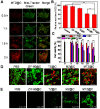ATP-triggered mitochondrial cascade reactions for cancer therapy with nanoscale zeolitic imidazole framework-90
- PMID: 34335969
- PMCID: PMC8315074
- DOI: 10.7150/thno.59593
ATP-triggered mitochondrial cascade reactions for cancer therapy with nanoscale zeolitic imidazole framework-90
Abstract
Goals: Chemotherapy, the most conventional modality for cancer therapy, usually brings serious side effects because of the low cancer-therapeutic specificity and bioavailability. It is of great significance for cancer treatment to develop new effective strategies to regulate biochemical reactions in organelles, enhance the specificity of chemotherapeutic drugs and reduce their side effects. Methods: We report herein a zeolitic imidazole framework-90 (ZIF-90) based nanoplatform, which was used to initiate a series of mitochondrial cascade reactions using ATP as a molecular switch for cancer therapy. The thioketal linked camptothecin (camptothecin prodrug, TK-CPT) and 2-Methoxyestradiol (2-ME) were encapsulated into the pores of ZIF-90 nanoparticles using a simple one-pot method, and the nanoplatform was finally coated with a layer of homologous cell membrane. Results: Mitochondrial ATP can efficiently degrade ZIF-90 and then release the loaded 2-ME and CPT prodrugs. 2-ME can inhibit the activity of superoxide dismutase (SOD), which induces the up-regulation of reactive oxygen species (ROS) in situ. The thioketal linkers in CPT prodrug can respond to ROS, thereby achieving subsequent release of parent CPT drug. This cascade of reactions can lead to prolonged high oxidative stress and cause continuous cancer cell apoptosis, due to the increased ROS level and the liberation of CPT. Conclusion: We constructed an ATP-triggered strategy using nanoscale ZIF-90 to initiate mitochondrial cascade reactions for cancer therapy. The ZIF-90 based nanoplatform exhibited low cytotoxicity, good mitochondria-targeting ability, and excellent therapeutic effect. In vivo experiments demonstrated that the growth of tumor can be efficiently inhibited in a mouse model. This ATP-triggered strategy to induce mitochondrial biochemical reactions offers more possibilities for developing organelle-targeted therapeutic platforms.
Keywords: 2-methoxyestradiol; ATP; camptothecine; reactive oxygen species; zeolitic imidazole framework-90.
© The author(s).
Conflict of interest statement
Competing Interests: The authors have declared that no competing interest exists.
Figures





Similar articles
-
Dual-Targeted Zeolitic Imidazolate Frameworks Drug Delivery System Reversing Cisplatin Resistance to Treat Resistant Ovarian Cancer.Int J Nanomedicine. 2024 Jul 3;19:6603-6618. doi: 10.2147/IJN.S434950. eCollection 2024. Int J Nanomedicine. 2024. PMID: 38979533 Free PMC article.
-
Mitochondria Targeted Nanoscale Zeolitic Imidazole Framework-90 for ATP Imaging in Live Cells.J Am Chem Soc. 2017 Apr 26;139(16):5877-5882. doi: 10.1021/jacs.7b01229. Epub 2017 Apr 14. J Am Chem Soc. 2017. PMID: 28385016
-
Nano-Scaled Zeolitic Imidazole Framework-8 as an Efficient Carrier for the Intracellular Delivery of RNase A in Cancer Treatment.Int J Nanomedicine. 2019 Dec 19;14:9971-9981. doi: 10.2147/IJN.S210107. eCollection 2019. Int J Nanomedicine. 2019. PMID: 31908453 Free PMC article.
-
Enhanced Antitumor Efficacy by a Cascade of Reactive Oxygen Species Generation and Drug Release.Angew Chem Int Ed Engl. 2019 Oct 7;58(41):14758-14763. doi: 10.1002/anie.201908997. Epub 2019 Sep 3. Angew Chem Int Ed Engl. 2019. PMID: 31429173 Review.
-
Functionalized ZIF-8 as a versatile platform for drug delivery and cancer therapy: strategies, challenges and prospects.J Mater Chem B. 2025 Mar 20;13(12):3758-3785. doi: 10.1039/d4tb02289k. J Mater Chem B. 2025. PMID: 40019146 Review.
Cited by
-
Res@ZIF-90 suppress gastric cancer progression by disturbing mitochondrial homeostasis.Transl Oncol. 2025 Jan;51:102179. doi: 10.1016/j.tranon.2024.102179. Epub 2024 Nov 6. Transl Oncol. 2025. PMID: 39509747 Free PMC article.
-
Multifunctional Mitochondria-Targeting Nanosystems for Enhanced Anticancer Efficacy.Front Bioeng Biotechnol. 2021 Nov 24;9:786621. doi: 10.3389/fbioe.2021.786621. eCollection 2021. Front Bioeng Biotechnol. 2021. PMID: 34900973 Free PMC article. Review.
-
Combining photodynamic therapy and cascade chemotherapy for enhanced tumor cytotoxicity: the role of CTT2P@B nanoparticles.Front Bioeng Biotechnol. 2024 Feb 12;12:1361966. doi: 10.3389/fbioe.2024.1361966. eCollection 2024. Front Bioeng Biotechnol. 2024. PMID: 38410166 Free PMC article.
-
Dual-Targeted Zeolitic Imidazolate Frameworks Drug Delivery System Reversing Cisplatin Resistance to Treat Resistant Ovarian Cancer.Int J Nanomedicine. 2024 Jul 3;19:6603-6618. doi: 10.2147/IJN.S434950. eCollection 2024. Int J Nanomedicine. 2024. PMID: 38979533 Free PMC article.
-
Spermine delivered by ZIF90 nanoparticles alleviates atherosclerosis by targeted inhibition of macrophage ferroptosis in plaque.J Nanobiotechnology. 2025 Mar 4;23(1):165. doi: 10.1186/s12951-025-03271-8. J Nanobiotechnology. 2025. PMID: 40038689 Free PMC article.
References
-
- Li N, Sun Q, Yu Z, Gao X, Pan W, Wan X. et al. Nuclear-targeted photothermal therapy prevents cancer recurrence with near-infrared triggered copper sulfide nanoparticles. ACS Nano. 2018;12:5197–206. - PubMed
-
- Seidi F, Jenjob R, Crespy D. Designing smart polymer conjugates for controlled release of payloads. Chem Rev. 2018;118:3965–4036. - PubMed
-
- Liu Z, Li T, Han F, Wang Y, Gan Y, Shi J. et al. A cascade-reaction enabled synergistic cancer starvation/ROS-mediated/chemo-therapy with an enzyme modified Fe-based MOF. Biomater Sci. 2019;7:3683–92. - PubMed
-
- Xu Q, He C, Xiao C, Chen X. Reactive oxygen species (ROS) responsive polymers for biomedical applications. Macromol Biosci. 2016;16:635–46. - PubMed
Publication types
MeSH terms
Substances
LinkOut - more resources
Full Text Sources

